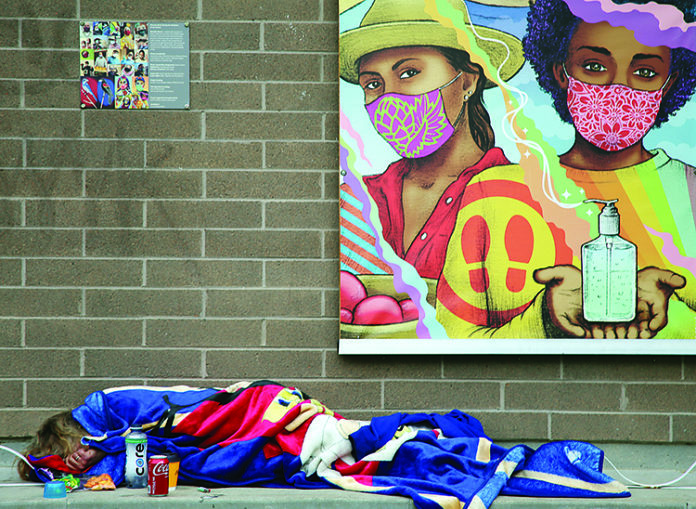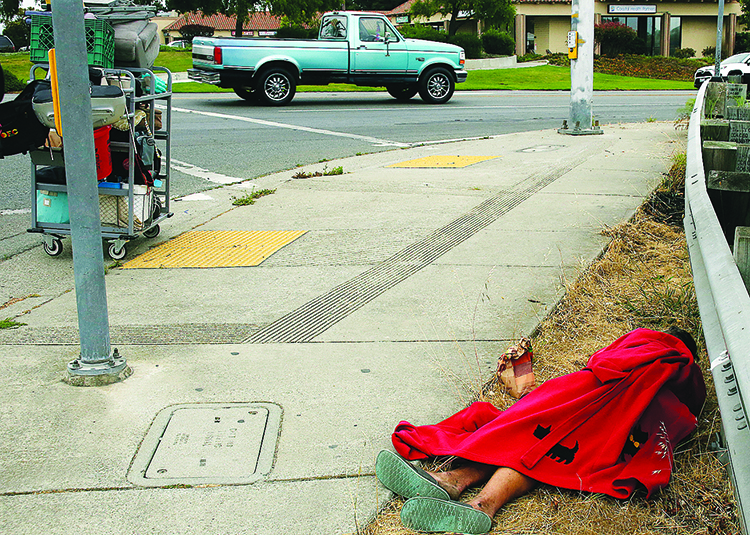
After Santa Cruz County last year saw a drop in the numbers of unhoused people, the numbers this year from the annual Point In Time (PIT) count conducted in January stayed mostly static.
The PIT Count is an estimate of the number of people experiencing homelessness on a single day.
In 2023, the PIT count showed a 21.5% decline, with this year’s numbers of people experiencing homelessness remaining essentially unchanged between 2023 and 2024, with a slight 2.6 percent increase to 1,850, according to data released Wednesday by Santa Cruz County Housing for Health (H4H).
The numbers show that efforts by homeless services providers are working, said H4H Director Robert Ratner.
“Last year’s numbers were the lowest ever recorded in Santa Cruz County, so it was gratifying to see that work validated in this year’s count,” Ratner said. “However, we have a long way to go before we can claim success, and there are many challenges ahead including the anticipated loss of critical State funding.”

p.p1 {margin: 0.0px 0.0px 0.0px 0.0px; line-height: 33.0px; font: 24.0px ‘Times New Roman’; color: #000000; -webkit-text-stroke: #000000} span.s1 {font-kerning: none}
A homeless man sleeps in the weeds outside the Crossroads Center on Main Street in Watsonville. (Tarmo Hannula/Pajaronian file)
A full version of the report will be released in July, which will give a geographic picture of where the homeless people were living.
Last year’s report showed a decline from 1,774 to 1,426 countywide, except for in the City of Watsonville, where the homeless population jumped from 175 in 2022 to 322.
While this year’s numbers are encouraging, Ratner said that the state is seeing increases in homelessness among seniors and people with disabilities.
That is due largely to the chasm between income and housing costs, which Ratner called a “a recipe for disaster.”
“The federal government should figure out how to close that gap between the cost of housing and people living on fixed income,” he said.
Ratner was referring to the preliminary budget by Gov. Gavin Newsom, which proposes the elimination of the Homeless Housing Assistance and Prevention block grant, which has been providing from $2 million to $6 million to Santa Cruz County every year.
“If that just disappears, then all the stuff we started and used the block grants over time, we’re going to have to shrink them down,” Ratner said.
The Governor also proposed eliminating the Home Safe program, for people involved in Adult Protective Service, and the Bringing Families Home program for families in the foster care system.
Ratner attributed some of the success to increased numbers of permanent housing vouchers, and to building more permanent supportive housing units. He also said that it’s important to coordinate with providers such as Housing Matters, Abode Services and Community Action Board.
“We layered services with vouchers and incentives for landlords, that whole package,” he said. “That to me is the thing we’ve done that’s made the biggest difference.”
Ratner stressed that treatment and other services must go hand-in-hand, because it’s hard to be healthy when someone doesn’t have a safe place to sleep.
“It always surprises me that people don’t understand that it’s hard to do treatment when people are in that situation,” he said.
•••
Key takeaways
The good
• The number of families experiencing homelessness declined from 76 to 52, with only four unsheltered families identified.
• Youth, 18–24 year-olds, without children in their household declined 40%, from 334 to 199.
• There was a 5% reduction in homelessness among children under 18.
• There was a 55% decline in the number of veterans experiencing homelessness, from 159 to 72.
The bad
• There was a 7% increase in homelessness among seniors, those aged 55 and over.
• The number of people with disabilities experiencing a year or more of homelessness increased 19% from 573 to 710.
• The number of people reporting severe mental illness increased by 5%, while those reporting long-term substance use disorders increased by 32%.











In 2023, the PIT count showed a 21.5% decline, with this year’s numbers of people experiencing homelessness remaining essentially unchanged between 2023 and 2024, with a slight 2.6 percent increase to 1,850,…Last year’s report showed a decline from 1,774 to 1,426 countywide, except for in the City of Watsonville, where the homeless population jumped from 175 in 2022 to 322.
Huh? Does this math make sense? In any case, are they now housed here? If so, are they working or are we paying for all their ‘needs’?
I think some hid from the census takers, some die off, and others go to LA for the weekend
The counts are a waste of time. Homeless population is what makes California what it is and how shows America how it treats people
Gavin Newsom that’s all you need to know. What? It’s been 10 years for his plan. I see it’s working just fine
We might ask ourselves why some huge cities, like Miami, have only 1000 homeless.
There is no prop 47 (and massive support spending) there, not allowing vagrants to openly walk out of stores with anything they desire to support themselves.